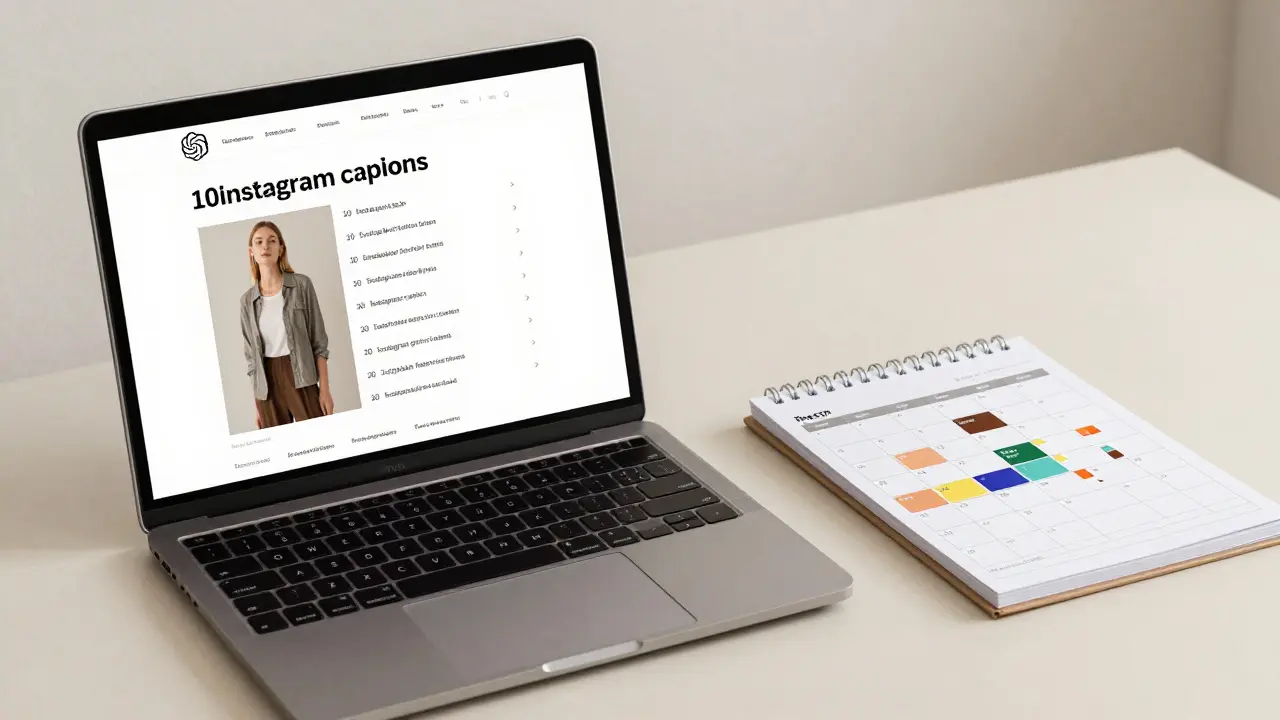ChatGPT for SMM Success: Plan, Write, and Scale Social Media in 2025

Your social media isn’t failing because your ideas are bad. It’s failing because your pipeline is slow, messy, and hard to repeat. ChatGPT fixes the pipeline-if you set it up right. Think brand voice locked, content calendar done, captions tuned for each platform, and insights distilled from messy analytics. It won’t magically replace strategy or taste. But it can cut hours from every week and boost output without sounding like a robot.
- TL;DR: Define your brand voice once, then reuse prompts to build calendars, captions, and briefs in minutes.
- Write platform-native posts with tight hooks, clear value, and a single CTA; let ChatGPT do the heavy lifting and you do the polishing.
- Feed it real performance data to iterate: ask for hypotheses, new angles, and test plans.
- Wrap it in guardrails: fact-check, disclosure, legal, accessibility, and brand approvals.
- Automate the boring bits (drafting, repurposing, alt text, summaries) and keep humans on taste, timing, and community care.
Build Your ChatGPT "Brand Brain" and Content Engine
If you treat ChatGPT like a blank page, you’ll get generic copy. Give it a brain and a job, and it becomes your best junior creative. I run campaigns out of Melbourne, and the teams who win in 2025 do one thing right: they load context upfront so every prompt starts on third base, not the parking lot.
Start with three assets:
- Audience snapshot: Top 3 segments, pains, desired outcomes, buying triggers, language they use.
- Brand voice rules: Tone sliders (e.g., Warm 8/10, Playful 6/10, Technical 3/10), banned phrases, reading level, emojis policy.
- Content pillars: 4-6 themes that map to the funnel: Problem, Proof, Product, People, POV, Play.
Paste those into a reusable system prompt like this:
You are the Brand Brain for [Brand]. Audience: [Segment notes]. Voice: [Tone sliders, banned words, examples]. Content pillars: [Pillars + purpose]. Goal this month: [e.g., webinar signups / trial starts]. Rules: write at Year 8 reading level, short sentences, one CTA, native to the platform, never make claims we can’t prove. Your jobs: draft content calendars, captions, hooks, alt text, prompts for visuals, and brief summaries of performance. Ask 3 clarifying questions before the first draft.
Then, give it a repeatable workflow. Here’s a weekly cadence that works for most brands:
- Plan: Ask for 10 post ideas per content pillar tied to one goal.
- Shape: Turn selected ideas into a 7-10 day grid (platform, hook, angle, CTA, asset type).
- Draft: Generate native captions, 3 hook options each, and an asset brief (shot list or design cues).
- Polish: You edit for taste, claims, and context; ChatGPT shortens, simplifies, or localizes on command.
- Ship: Export to CSV/Google Sheets format; add UTM tags.
- Learn: Feed performance back in; ask for what to try next.
Prompt templates you’ll actually reuse:
- Calendar: “Create a 14-day content plan for Instagram, LinkedIn, and TikTok. Goal: [X]. Use pillars [A-D]. Output as a table with date, platform, post goal, hook, caption (150 words max), CTA, asset idea.”
- Caption: “Write 3 versions of a LinkedIn post for [audience] that argues [POV]. Keep it under 220 words, bold the key sentence, add 2 hashtags, no emojis. Offer a DM CTA for the checklist.”
- Ad copy: “Meta ad primary text (max 125 chars), headline (max 40), description (max 30). Problem-Agitate-Solve, proof with [stat/case], one benefit, one CTA.”
- Asset brief: “Turn this caption into a 20-second Reels shot list: 5 shots, each with framing, on-screen text, and beat timing.”
- Repurpose: “From this 700-word blog, create: 1 LinkedIn carousel outline, 2 X threads (6 tweets each), 1 TikTok script with hook in 3 takes.”
Checklist to keep it on the rails:
- Paste audience + voice rules into every new chat thread.
- Ask it to summarize your brief back to you; fix misunderstandings before drafting.
- Limit each ask: one platform, one goal, one CTA.
- Set character caps in the prompt; it will comply 90% of the time.
- Always request 3 options; pick and merge the best lines.
Write Platform-Native Posts That Sound Human
Same idea, different rooms. TikTok wants motion and attitude. LinkedIn wants a clear argument. Instagram wants you to get to the point and make it pretty. ChatGPT can translate the same message across rooms without losing your voice.
Use simple frameworks:
- Hook-Value-CTA: Lead with a punchy claim or question, deliver one useful thing, ask for one action.
- Before-After-Bridge: Show the pain, paint the after, show the path.
- Problem-Proof-Pitch: Works for ads and launches; swap proof type based on platform norms.
- Rule of One: One idea per post. One link max. One ask. Makes analytics cleaner, too.
Per-platform heuristics I use in 2025:
- Instagram: Reels and carousels carry reach. Keep captions tight upfront. Put the CTA in the first 3 lines. Hashtags: 3-5 relevant, not broad spam.
- TikTok: Script for the first 2 seconds. On-screen text matters. Captions can be short; use keywords naturally, not as keyword soup.
- LinkedIn: First line is the whole game. Cut the preamble. Make one claim, add a quick proof, then a clean CTA (comment, DM, link-in-first-comment).
- X: Keep threads scannable. One idea per tweet, skip filler. Visuals beat walls of text.
- YouTube Shorts: Promise in the first frame, pay off by 0:10. Caption supports discovery; title does the heavy lifting.
Use this prompt pattern to go native:
Take this message: [core idea]. Keep voice rules. Write platform-native versions for Instagram (Reel caption 120 words), TikTok (script 20s), LinkedIn (180-220 words), and X (thread, 6 tweets). Add a unique hook to each.
Reality check for claims and compliance: ask ChatGPT to flag risky or unverifiable lines. Then verify yourself. If you operate in Australia, match the AANA Code of Ethics (2024) and ACCC influencer guidance on disclosure. If you’re global, mirror your market’s advertising standards. Keep #ad clear and conspicuous where needed.
| Platform | Native Focus (2025) | Caption Length Tip | Cadence Rule of Thumb | Where ChatGPT Helps Most |
|---|---|---|---|---|
| Reels, Carousels, Stories | Front-load: first 150-200 chars count | 3-5 posts/week + daily Stories | Hooks, carousel outlines, alt text, hashtag refining | |
| TikTok | Short vertical video | Short; include keywords naturally | 3-7 videos/week | Script beats, on-screen text, shot lists |
| Text posts, Carousels, Native docs | 150-220 words, punchy first line | 3-5 posts/week | POV posts, case summaries, carousel copy | |
| X | Threads, Visual one-liners | Short lines, one idea each | Daily short posts | Thread structuring, concise rewrites |
| YouTube Shorts | 60s vertical video | Title matters more than description | 2-4/week | Titles, hooks, chapter ideas for longform tie-ins |
Example: one idea across platforms
- Core idea: “You don’t need more content; you need faster feedback loops.”
- LinkedIn (first line): “Most teams don’t need more posts. They need a tighter loop.” Value: 3-step loop. CTA: “Comment ‘LOOP’ for the template.”
- Instagram (Reel): Hook on-screen: “Stop posting more. Start learning faster.” Shots: dashboard → sticky note loop → CTA overlay “DM LOOP”.
- TikTok: Cold open: “Your calendar is lying to you.” 3 beats. CTA: “I’ll send the Google Sheet-comment LOOP.”
- X thread: Tweet 1: “Stop scaling posts. Scale feedback.” Follow with 5 micro-tactics.
Quick caption polish prompts:
- “Compress to 120 words, keep the punch, remove filler.”
- “Swap generic adjectives for concrete nouns.”
- “Rewrite for Year 8 reading level without losing nuance.”
- “Add 2 non-spammy hashtags based on the copy.”

Turn Data Into Better Creative (Without a Data Team)
Performance without interpretation is noise. Feed ChatGPT a trimmed export and ask it for patterns, hypotheses, and test plans. You still decide what’s interesting; it speeds the thinking.
Setup your “Analyst” prompt:
You are a social performance analyst. Metrics: impressions, reach, engagement rate (ER = interactions/reach), saves, shares, clicks, CTR, cost per result. Goal: [e.g., webinar signups]. Given a CSV summary (max 300 rows), group posts by pillar and format, identify top/bottom quartile, and propose 5 hypotheses and a 2-week test plan. Keep jargon out. Show what to stop, start, and double down on.
What to feed it:
- A sample of the last 30-90 days (not the whole year).
- A mapping of each post to a content pillar and format.
- Key dates (launches, sales, PR hits) to avoid false wins.
Useful outputs to request:
- Hypothesis list: e.g., “Carousel ‘how-to’ posts drive saves; test more step-by-step formats.”
- Creative briefs: “Turn hypothesis #2 into a 3-post test with hooks, CTAs, and asset notes.”
- UTM builder: “Generate UTM tags for each post with campaign=[campaign_name], content=[platform_postID_hook].”
- Competitor scan: Paste 10 recent posts from a competitor; ask for patterns to zig where they zag.
Ad optimization prompts:
- “Summarize creative patterns from these 12 Meta ads (primary text + headline + CPA). Propose 3 new angles and 2 thumb-stopping first lines per angle.”
- “Rewrite the winning copy for 3 segments: [ICP1, ICP2, ICP3]. Keep the proof, change the pain.”
- “Draft 5 variations under 125 characters for the primary text, focusing on benefit, not feature.”
Rules of thumb that travel well:
- 70/20/10 mix: 70% value, 20% credibility (proof/case), 10% direct pitch.
- Test small, learn fast: 2 hooks x 2 creatives beats boiling the ocean.
- One KPI per campaign: don’t chase saves and clicks and follows in the same flight.
- ER sanity check: cut outliers driven by giveaways before you crown a winner.
Accessibility and quality wins you can automate:
- “Write alt text for this image: [paste description]. Keep under 120 chars.”
- “Generate clean, sentence-case captions from this transcript. Mark speakers, fix timestamps.”
- “Create on-screen text for a 15s Short that matches the voiceover beats.”
Credibility note: Large reports in 2025 (e.g., Sprout Social Index, Hootsuite Social Trends, and HubSpot’s AI in Marketing research) keep showing the same pattern-teams that use AI to draft and analyze spend more time on creative judgment and community, and they ship more tests per month. That’s where the real lift comes from.
Safety, Scale, and the Boring but Critical Guardrails
Speed is great until a sloppy claim hits a regulator, or a careless post breaks trust. Put guardrails in your workflow so you can scale without stepping on landmines.
Legal and brand safety checklist (adapt per region):
- Claims: Ask ChatGPT to highlight anything that looks like a guarantee or medical/financial promise. Verify with sources you control.
- Disclosure: Use clear #ad/#sponsored. In Australia, follow AANA Codes (2024) and ACCC influencer guidance. In the US/UK, follow FTC/ASA rules.
- Privacy: Don’t paste personal data. Obfuscate names/emails. Use redacted screenshots when needed.
- Copyright: Generate ideas, not logos or trademarked taglines. Always license visuals.
- Accessibility: Alt text on images, captions on videos, high-contrast templates, avoid flashing effects.
Quality gate before posting:
- Have ChatGPT write the post, but a human signs off on meaning, tone, and risk.
- Run a “plain English” pass: “Rewrite to be clear and concrete; replace buzzwords with examples.”
- Read it out loud. If you feel awkward, fix it.
- Check the first 2 lines on mobile preview. That’s your only guaranteed real estate.
Automation ideas that save hours without nuking quality:
- Repurposing chain: New blog goes live → Zapier sends summary to ChatGPT → drafts LinkedIn post + carousel outline → sends to a Google Doc for human edit.
- Daily summary: Scheduler exports yesterday’s metrics → ChatGPT produces a 3-bullet “what changed” note in Slack.
- Community triage: ChatGPT drafts friendly first responses for FAQs; your team personalizes before sending. Don’t auto-respond to sensitive issues.
Cost/time sanity check:
- Drafting: Expect 50-70% time saved on first drafts once your Brand Brain is set.
- Editing: Don’t shortchange this. Plan 5-10 minutes per post for human polish.
- Analysis: 3x faster to reach testable hypotheses when you feed clean samples.
House style to keep you sounding human:
- Short sentences. One idea per line. Kill preambles.
- Specifics beat adjectives. Replace “innovative” with “cut setup time from 2 hours to 15 minutes.”
- Names and nouns: tools, templates, numbers, real examples.
Mini-FAQ
- Will AI make my posts sound the same as everyone else? Not if you feed it your voice, examples, and banned words. Give it taste, it gives you speed.
- Is it safe to let ChatGPT talk to customers? Drafting is fine. For public replies, keep a human in the loop. Escalate sensitive topics.
- How do I measure AI’s impact? Track hours saved per asset, tests shipped per month, and lift in your one KPI (e.g., CTR or signups). Compare pre/post for 30-60 days.
- What about prompts getting “stale”? Refresh your Brand Brain quarterly. Add new wins, losses, and examples.
- Which plan do I need? For teams, paid tiers help with longer context windows and attachments. Choose the lowest plan that lets you paste briefs and files comfortably.
Next steps
- Collect your audience notes, voice rules, and pillars into one doc. This is your Brand Brain seed.
- Spin up a fresh chat. Paste the Brand Brain. Ask for 10 post ideas per pillar. Choose 8.
- Generate a 14-day calendar and first drafts. Edit for taste. Schedule 3 days ahead.
- Export last 30 days of performance. Paste summaries. Ask for 5 hypotheses and a 2-week test plan.
- Pick one automation (repurposing chain or daily summary). Set it up with Zapier/Make.
Troubleshooting
- Everything sounds generic: Paste 3 of your best past posts and say “match this rhythm.” Add banned words. Demand concrete examples.
- Too long, keeps rambling: Set hard character caps and ask for bullet scaffolds first, then prose.
- Wrong audience level: Specify reading level and domain knowledge. “Assume reader is a first-time founder in fintech, not an engineer.”
- Overconfident claims: Ask it to flag risky lines. Replace with proof you can cite or a softer phrasing.
- Stuck on ideation: Feed in 5 competitor posts and 5 customer questions. Ask for angles that oppose the obvious.
Last nudge: AI won’t give you taste. It will give you time to practice taste. Use it to ship more tests, talk to more customers, and land cleaner stories. That’s how you win feeds in 2025.
Use ChatGPT for SMM as the engine, not the driver. You’ll move faster-and sound more like you at your best.



